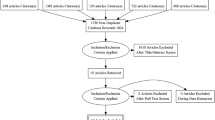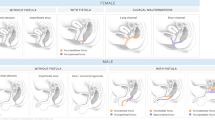Abstract
Background
Fluoroscopy time has been used as a surrogate for radiation dose monitoring in pediatric fluoroscopy; however it does not account for factors such as magnification or collimation. Dose–area product (DAP) is a more accurate measure of radiation exposure but its dependence on patient weight and body-part thickness is a challenge in children of varying ages.
Objective
To determine whether fluoroscopy time and DAP produce concurrent results when they are used to identify high-exposure cases, and to establish radiation dose thresholds for our institution.
Materials and methods
During a 2-year period we prospectively monitored pediatric fluoroscopy studies performed at the Children’s Hospital at Montefiore. We recorded study type, fluoroscopy time, DAP, patient age, weight and height. We then calculated 90th percentile fluoroscopy time and DAP thresholds for weight and age.
Results
We evaluated 1,011 cases (453 upper gastrointestinal [UGI] series, 266 voiding cystourethrograms [VCUGs], 120 contrast enemas, 108 speech studies, and 64 esophagrams). Fluoroscopy time demonstrated moderate correlation with DAP (rs=0.45, P<0.001, Spearman rank). DAP strongly correlated with patient weight (rs=0.71, P<0.001) and age (rs=0.70, P<0.001). Concordance of cases exceeding 90th percentile thresholds for fluoroscopy time and DAP were κ=0.27 for UGI series and κ=0.49 for VCUG for weight-based cutoffs, and κ=0.36 for UGI series and κ=0.40 for VCUG for age-based cutoffs.
Conclusion
The limited correlation of fluoroscopy time with DAP suggests these methods are not equivalent for dose monitoring. However, the strong correlation of DAP with patient weight and age presents a challenge for establishing DAP thresholds in children, who range widely in size. Despite controlling for weight or age, there was limited overlap of cases exceeding the 90th percentile threshold for fluoroscopy time and DAP. This further reinforces the non-overlapping outcome of these two methods and indicates that fluoroscopy time might be inadequate for dose monitoring.


Similar content being viewed by others
References
Hernanz-Schulman M, Goske MJ, Bercha IH et al (2011) Pause and pulse: ten steps that help manage radiation dose during pediatric fluoroscopy. AJR Am J Roentgenol 197:475–481
Hernandez RJ, Goodsitt MM (1996) Reduction of radiation dose in pediatric patients using pulsed fluoroscopy. AJR Am J Roentgenol 167:1247–1253
Lederman HM, Khademian ZP, Felice M et al (2002) Dose reduction fluoroscopy in pediatrics. Pediatr Radiol 32:844–848
Ward VL, Strauss KJ, Barnewolt CE et al (2008) Pediatric radiation exposure and effective dose reduction during voiding cystourethrography. Radiology 249:1002–1009
Brown PH, Thomas RD, Silberberg PJ et al (2000) Optimization of a fluoroscope to reduce radiation exposure in pediatric imaging. Pediatr Radiol 30:229–235
Hansson B, Finnbogason T, Schuwert P et al (1997) Added copper filtration in digital paediatric double-contrast colon examinations: effects on radiation dose and image quality. Eur Radiol 7:1117–1122
Nicholson RA, Thornton A, Akpan M (1995) Radiation dose reduction in paediatric fluoroscopy using added filtration. Br J Radiol 68:296–300
Jaju A, Shaw HL, Don S et al (2015) ALARA: impact of practice quality improvement initiative on dose reduction in pediatric voiding cystourethrogram. AJR Am J Roentgenol 205:886–893
Fefferman NR, Sabach AS, Rivera R et al (2009) The efficacy of digital fluoroscopic image capture in the evaluation of vesicoureteral reflux in children. Pediatr Radiol 39:1179–1187
Brown PH, Silberberg PJ, Thomas RD et al (2000) A multihospital survey of radiation exposure and image quality in pediatric fluoroscopy. Pediatr Radiol 30:236–242
Duncan JR, Panahipour S, Street M (2015) Monitoring patient exposure during fluoroscopic procedures: how we do it. J Am Coll Radiol 12:617–619
Strauss KJ, Kaste SC (2006) The ALARA (as low as reasonably achievable) concept in pediatric interventional and fluoroscopic imaging: striving to keep radiation doses as low as possible during fluoroscopy of pediatric patients — a white paper executive summary. Radiology 240:621–622
American College of Radiology (2016) Physician quality reporting system measure #145: radiology: exposure time reported for procedures using fluoroscopy – national quality strategy domain: patient safety. https://qpp.cms.gov/docs/QPP_quality_measure_specifications/Claims-Registry-Measures/2017_Measure_145_Registry.pdf. Accessed 3 Dec 2018
Stecker MS, Balter S, Towbin RB et al (2009) Guidelines for patient radiation dose management. J Vasc Interv Radiol 20:S263–S273
Pantos I, Patatoukas G, Katritsis DG et al (2009) Patient radiation doses in interventional cardiology procedures. Curr Cardiol Rev 5:1–11
Ghodadra A, Bartoletti S (2016) Reducing radiation dose in pediatric diagnostic fluoroscopy. J Am Coll Radiol 13:55–58
Rao AG, Simmons CE Sr, Thacker PG et al (2016) Radiation exposure contribution of the scout abdomen radiograph in common pediatric fluoroscopic procedures. Pediatr Radiol 46:1241–1248
Wambani JS, Korir GK, Tries MA et al (2014) Patient radiation exposure during general fluoroscopy examinations. J Appl Clin Med Phys 15:4555
Chida K, Ohno T, Kakizaki S et al (2010) Radiation dose to the pediatric cardiac catheterization and intervention patient. AJR Am J Roentgenol 195:1175–1179
Ghelani SJ, Glatz AC, David S et al (2014) Radiation dose benchmarks during cardiac catheterization for congenital heart disease in the United States. J Am Coll Cardiol Intv 7:1060–1069
Mahesh M (2001) Fluoroscopy: patient radiation exposure issues. Radiographics 21:1033–1045
Nickoloff EL, Lu ZF, Dutta AK et al (2008) Radiation dose descriptors: BERT, COD, DAP, and other strange creatures. Radiographics 28:1439–1450
Miller DL, Balter S, Cole PE et al (2003) Radiation doses in interventional radiology procedures: the RAD-IR study: part I: overall measures of dose. J Vasc Interv Radiol 14:711–727
Centers for Disease Control and Prevention (2009) Clinical growth charts. https://www.cdc.gov/growthcharts/clinical_charts.htm. Accessed 3 Dec 2018
Anvari A, Halpern EF, Samir AE (2015) Statistics 101 for radiologists. Radiographics 35:1789–1801
Hart D, Hillier M, Shrimpton P (2012) Doses to patients from radiographic and fluoroscopic X-ray imaging procedures in the UK — 2010 review. Health Protection Agency Centre for Radiation, Chemical, and Environmental Hazards, Oxfordshire
Author information
Authors and Affiliations
Corresponding author
Ethics declarations
Conflicts of interest
None
Additional information
Publisher’s note
Springer Nature remains neutral with regard to jurisdictional claims in published maps and institutional affiliations.
Electronic supplementary material
Supplementary Table S1
(DOCX 12 kb)
Supplementary Table S2
(DOCX 16 kb)
Supplementary Table S3
(DOCX 18.8 kb)
Rights and permissions
About this article
Cite this article
Lazarus, M.S., Taragin, B.H., Malouf, W. et al. Radiation dose monitoring in pediatric fluoroscopy: comparison of fluoroscopy time and dose–area product thresholds for identifying high-exposure cases. Pediatr Radiol 49, 600–608 (2019). https://doi.org/10.1007/s00247-018-04335-8
Received:
Revised:
Accepted:
Published:
Issue Date:
DOI: https://doi.org/10.1007/s00247-018-04335-8




